Zichao Wang
Principled Content Selection to Generate Diverse and Personalized Multi-Document Summaries
May 28, 2025Abstract:While large language models (LLMs) are increasingly capable of handling longer contexts, recent work has demonstrated that they exhibit the "lost in the middle" phenomenon (Liu et al., 2024) of unevenly attending to different parts of the provided context. This hinders their ability to cover diverse source material in multi-document summarization, as noted in the DiverseSumm benchmark (Huang et al., 2024). In this work, we contend that principled content selection is a simple way to increase source coverage on this task. As opposed to prompting an LLM to perform the summarization in a single step, we explicitly divide the task into three steps -- (1) reducing document collections to atomic key points, (2) using determinantal point processes (DPP) to perform select key points that prioritize diverse content, and (3) rewriting to the final summary. By combining prompting steps, for extraction and rewriting, with principled techniques, for content selection, we consistently improve source coverage on the DiverseSumm benchmark across various LLMs. Finally, we also show that by incorporating relevance to a provided user intent into the DPP kernel, we can generate personalized summaries that cover relevant source information while retaining coverage.
A Personalized Conversational Benchmark: Towards Simulating Personalized Conversations
May 20, 2025Abstract:We present PersonaConvBench, a large-scale benchmark for evaluating personalized reasoning and generation in multi-turn conversations with large language models (LLMs). Unlike existing work that focuses on either personalization or conversational structure in isolation, PersonaConvBench integrates both, offering three core tasks: sentence classification, impact regression, and user-centric text generation across ten diverse Reddit-based domains. This design enables systematic analysis of how personalized conversational context shapes LLM outputs in realistic multi-user scenarios. We benchmark several commercial and open-source LLMs under a unified prompting setup and observe that incorporating personalized history yields substantial performance improvements, including a 198 percent relative gain over the best non-conversational baseline in sentiment classification. By releasing PersonaConvBench with evaluations and code, we aim to support research on LLMs that adapt to individual styles, track long-term context, and produce contextually rich, engaging responses.
UniEDU: A Unified Language and Vision Assistant for Education Applications
Mar 26, 2025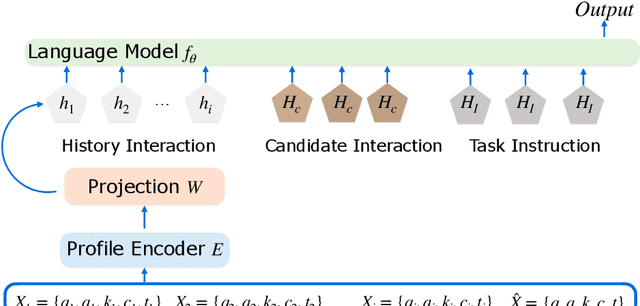
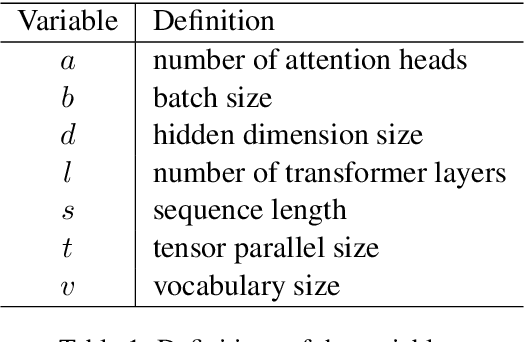
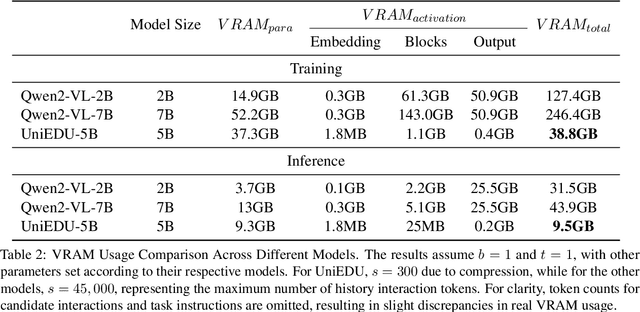
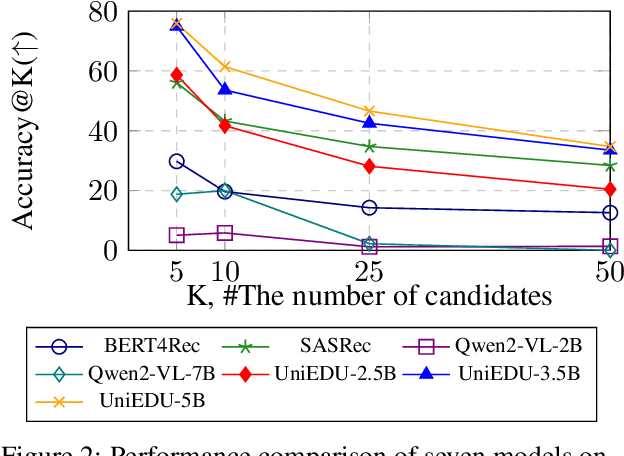
Abstract:Education materials for K-12 students often consist of multiple modalities, such as text and images, posing challenges for models to fully understand nuanced information in these materials. In this paper, we propose a unified language and vision assistant UniEDU designed for various educational applications, including knowledge recommendation, knowledge tracing, time cost prediction, and user answer prediction, all within a single model. Unlike conventional task-specific models, UniEDU offers a unified solution that excels across multiple educational tasks while maintaining strong generalization capabilities. Its adaptability makes it well-suited for real-world deployment in diverse learning environments. Furthermore, UniEDU is optimized for industry-scale deployment by significantly reducing computational overhead-achieving approximately a 300\% increase in efficiency-while maintaining competitive performance with minimal degradation compared to fully fine-tuned models. This work represents a significant step toward creating versatile AI systems tailored to the evolving demands of education.
A Survey on Mechanistic Interpretability for Multi-Modal Foundation Models
Feb 22, 2025



Abstract:The rise of foundation models has transformed machine learning research, prompting efforts to uncover their inner workings and develop more efficient and reliable applications for better control. While significant progress has been made in interpreting Large Language Models (LLMs), multimodal foundation models (MMFMs) - such as contrastive vision-language models, generative vision-language models, and text-to-image models - pose unique interpretability challenges beyond unimodal frameworks. Despite initial studies, a substantial gap remains between the interpretability of LLMs and MMFMs. This survey explores two key aspects: (1) the adaptation of LLM interpretability methods to multimodal models and (2) understanding the mechanistic differences between unimodal language models and crossmodal systems. By systematically reviewing current MMFM analysis techniques, we propose a structured taxonomy of interpretability methods, compare insights across unimodal and multimodal architectures, and highlight critical research gaps.
From Selection to Generation: A Survey of LLM-based Active Learning
Feb 17, 2025Abstract:Active Learning (AL) has been a powerful paradigm for improving model efficiency and performance by selecting the most informative data points for labeling and training. In recent active learning frameworks, Large Language Models (LLMs) have been employed not only for selection but also for generating entirely new data instances and providing more cost-effective annotations. Motivated by the increasing importance of high-quality data and efficient model training in the era of LLMs, we present a comprehensive survey on LLM-based Active Learning. We introduce an intuitive taxonomy that categorizes these techniques and discuss the transformative roles LLMs can play in the active learning loop. We further examine the impact of AL on LLM learning paradigms and its applications across various domains. Finally, we identify open challenges and propose future research directions. This survey aims to serve as an up-to-date resource for researchers and practitioners seeking to gain an intuitive understanding of LLM-based AL techniques and deploy them to new applications.
On Mechanistic Circuits for Extractive Question-Answering
Feb 12, 2025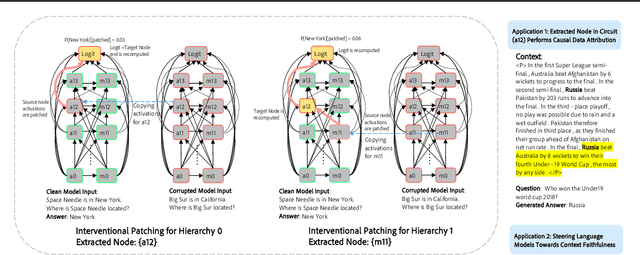
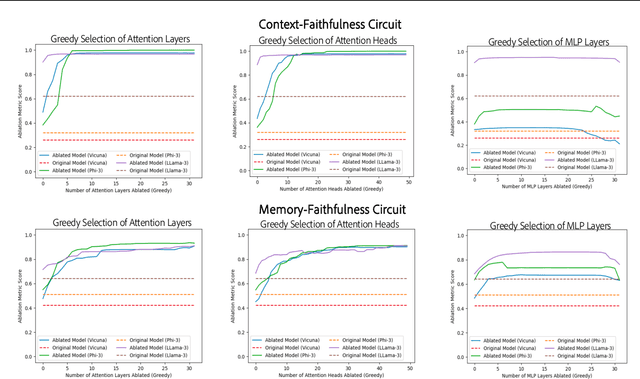

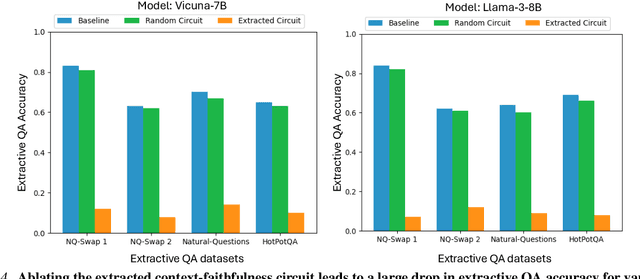
Abstract:Large language models are increasingly used to process documents and facilitate question-answering on them. In our paper, we extract mechanistic circuits for this real-world language modeling task: context-augmented language modeling for extractive question-answering (QA) tasks and understand the potential benefits of circuits towards downstream applications such as data attribution to context information. We extract circuits as a function of internal model components (e.g., attention heads, MLPs) using causal mediation analysis techniques. Leveraging the extracted circuits, we first understand the interplay between the model's usage of parametric memory and retrieved context towards a better mechanistic understanding of context-augmented language models. We then identify a small set of attention heads in our circuit which performs reliable data attribution by default, thereby obtaining attribution for free in just the model's forward pass. Using this insight, we then introduce ATTNATTRIB, a fast data attribution algorithm which obtains state-of-the-art attribution results across various extractive QA benchmarks. Finally, we show the possibility to steer the language model towards answering from the context, instead of the parametric memory by using the attribution from ATTNATTRIB as an additional signal during the forward pass. Beyond mechanistic understanding, our paper provides tangible applications of circuits in the form of reliable data attribution and model steering.
Persona-SQ: A Personalized Suggested Question Generation Framework For Real-world Documents
Dec 17, 2024



Abstract:Suggested questions (SQs) provide an effective initial interface for users to engage with their documents in AI-powered reading applications. In practical reading sessions, users have diverse backgrounds and reading goals, yet current SQ features typically ignore such user information, resulting in homogeneous or ineffective questions. We introduce a pipeline that generates personalized SQs by incorporating reader profiles (professions and reading goals) and demonstrate its utility in two ways: 1) as an improved SQ generation pipeline that produces higher quality and more diverse questions compared to current baselines, and 2) as a data generator to fine-tune extremely small models that perform competitively with much larger models on SQ generation. Our approach can not only serve as a drop-in replacement in current SQ systems to immediately improve their performance but also help develop on-device SQ models that can run locally to deliver fast and private SQ experience.
Personalization of Large Language Models: A Survey
Oct 29, 2024Abstract:Personalization of Large Language Models (LLMs) has recently become increasingly important with a wide range of applications. Despite the importance and recent progress, most existing works on personalized LLMs have focused either entirely on (a) personalized text generation or (b) leveraging LLMs for personalization-related downstream applications, such as recommendation systems. In this work, we bridge the gap between these two separate main directions for the first time by introducing a taxonomy for personalized LLM usage and summarizing the key differences and challenges. We provide a formalization of the foundations of personalized LLMs that consolidates and expands notions of personalization of LLMs, defining and discussing novel facets of personalization, usage, and desiderata of personalized LLMs. We then unify the literature across these diverse fields and usage scenarios by proposing systematic taxonomies for the granularity of personalization, personalization techniques, datasets, evaluation methods, and applications of personalized LLMs. Finally, we highlight challenges and important open problems that remain to be addressed. By unifying and surveying recent research using the proposed taxonomies, we aim to provide a clear guide to the existing literature and different facets of personalization in LLMs, empowering both researchers and practitioners.
VipAct: Visual-Perception Enhancement via Specialized VLM Agent Collaboration and Tool-use
Oct 21, 2024



Abstract:While vision-language models (VLMs) have demonstrated remarkable performance across various tasks combining textual and visual information, they continue to struggle with fine-grained visual perception tasks that require detailed pixel-level analysis. Effectively eliciting comprehensive reasoning from VLMs on such intricate visual elements remains an open challenge. In this paper, we present VipAct, an agent framework that enhances VLMs by integrating multi-agent collaboration and vision expert models, enabling more precise visual understanding and comprehensive reasoning. VipAct consists of an orchestrator agent, which manages task requirement analysis, planning, and coordination, along with specialized agents that handle specific tasks such as image captioning and vision expert models that provide high-precision perceptual information. This multi-agent approach allows VLMs to better perform fine-grained visual perception tasks by synergizing planning, reasoning, and tool use. We evaluate VipAct on benchmarks featuring a diverse set of visual perception tasks, with experimental results demonstrating significant performance improvements over state-of-the-art baselines across all tasks. Furthermore, comprehensive ablation studies reveal the critical role of multi-agent collaboration in eliciting more detailed System-2 reasoning and highlight the importance of image input for task planning. Additionally, our error analysis identifies patterns of VLMs' inherent limitations in visual perception, providing insights into potential future improvements. VipAct offers a flexible and extensible framework, paving the way for more advanced visual perception systems across various real-world applications.
Synthetic Context Generation for Question Generation
Jun 19, 2024Abstract:Despite rapid advancements in large language models (LLMs), QG remains a challenging problem due to its complicated process, open-ended nature, and the diverse settings in which question generation occurs. A common approach to address these challenges involves fine-tuning smaller, custom models using datasets containing background context, question, and answer. However, obtaining suitable domain-specific datasets with appropriate context is often more difficult than acquiring question-answer pairs. In this paper, we investigate training QG models using synthetic contexts generated by LLMs from readily available question-answer pairs. We conduct a comprehensive study to answer critical research questions related to the performance of models trained on synthetic contexts and their potential impact on QG research and applications. Our empirical results reveal: 1) contexts are essential for QG tasks, even if they are synthetic; 2) fine-tuning smaller language models has the capability of achieving better performances as compared to prompting larger language models; and 3) synthetic context and real context could achieve comparable performances. These findings highlight the effectiveness of synthetic contexts in QG and paves the way for future advancements in the field.
 Add to Chrome
Add to Chrome Add to Firefox
Add to Firefox Add to Edge
Add to Edge